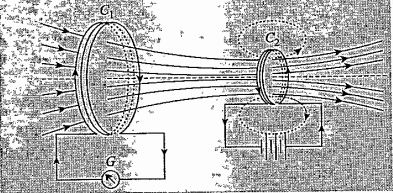નીચેની આકૃતિમાં દર્શાવેલા I જેટલી બાજુની લંબાઈવાળા સમબાજુ ΔABC નાં શિરોબિંદુઓ A, B, C પર મૂકેલા બિંદુવત વિદ્યુતભારો અનુક્રમે q, q, -q પરના પરિણામી કુલંબીય બળો શોધો.
Step by step video & image solution for નીચેની આકૃતિમાં દર્શાવેલા I જેટલી બાજુની લંબાઈવાળા સમબાજુ DeltaABC નાં શિરોબિંદુઓ A, B, C પર મૂકેલા બિંદુવત વિદ્યુતભારો અનુક્રમે q, q, -q પરના પરિણામી કુલંબીય બળો શોધો. by Physics experts to help you in doubts & scoring excellent marks in Class 12 exams.
Updated on:21/07/2023Topper's Solved these Questions
- વિદ્યુતભારો અને ક્ષેત્રો (ELECTRIC CHARGES AND FIELDS)Book:VIRAJ PUBLICATIONChapter:વિદ્યુતભારો અને ક્ષેત્રો (ELECTRIC CHARGES AND FIELDS)Exercise:Example
Explore 67 Videos
- વિદ્યુતચુંબકીય પ્રેરણ (ELECTROMAGNATIC INDUCTION)Book:VIRAJ PUBLICATIONChapter:વિદ્યુતચુંબકીય પ્રેરણ (ELECTROMAGNATIC INDUCTION)Exercise: Example
Explore 43 Videos
- સંદેશા વ્યવહાર તંત્રો (COMMUNICATION SYSTEMS)Book:VIRAJ PUBLICATIONChapter:સંદેશા વ્યવહાર તંત્રો (COMMUNICATION SYSTEMS)Exercise:Example
Explore 11 Videos
Similar Questions
પદાર્થ 1 માંથી પદાર્થ 2 તરફ પ્રતિ સેકન્ડે 109 ઇલેક્ટ્રોન્સ વહન પામે તો કેટલા સમયને અંતે પદાર્થ 2 પરનો વિદ્યુતભાર 1 C જેટલો બનશે ?
View Solutionઆપેલ આકૃતિમાં દર્શાવેલી ગોઠવણ ધ્યાનમાં લો. ગેલ્વેનોમીટરમાં મોટું કોણીય આવર્તન મેળવવા માટે તમે શું કરશો ?

View Solutionપ્રુથ્વીની સપાટીથી 32 m ઊંચાઈ ધરાવતા ટ્રાન્સમીટર એન્ટેના તથા 50 m ઊચાઈ ધરાવતા રીસીવર એન્ટેના વચ્ચેના કેટલા મહત્તમ અંતર સુધી તેમની વચ્ચે સંતોષકારક દ્રષ્ટિરેખા સંદેશા વ્યવહાર થઈ શકશે ? (પ્રુથ્વીની ત્રિજ્યા 6.4×106m છે.)
View SolutionGiven A=⎡⎢⎣pbcaqcabr⎤⎥⎦. If det(A)=0 and a≠p,b≠q,c≠q, then prove pp−a+qq−b+rr−c=2.
View SolutionIf p+q+r=0=a+b+c, then the value of the determnalnt |paqbrcqcrapbrbpcqa|is 0 b. pa+qb+rc c. 1 d. none of these
View Solutiona!=p,b!=q,c!=r and det[[p,b,ca,q,ca,q,ca,b,r]] value of (p)/(p-a)+(q)/(q-b)+(r)/(r-c),=
View SolutionIn ABC , P divides the side AB such that AP:PB=1:2 . Q is a point in AC such that PQBC . Find the ratio of the areas of APQ and trapezium BPQC .
View SolutionIf pth, qth and rth terms of an A.P. are a,b,c, respectively, then show that
(i) a(q-r)+b(r-p)+c(p-q)=0
(ii) (a-b)r+(b-c)p+(c-a)q=0
View SolutionIf p+q+r=0=a+b+c, then the value of the determinant ∣∣ ∣ ∣∣paqbrcqcrapbrbpcqa∣∣ ∣ ∣∣is (a)0 (b) pa+qb+rc (c) 1 (d) none of these
View SolutionIf a,b,andc are in A.P. p,q,andr are in H.P., and ap,bq,andcr are in G.P., then pr+rp is equal to ac−ca b. ac+ca c. bq+qb d. bq−qb
View SolutionIf a,b,andc are in A.P. p,q,andr are in H.P., and ap,bq,andcr are in G.P., then pr+rp is equal to ac−ca b. ac+ca c. bq+qb d. bq−qb
View SolutionIn Fig. (i) and (ii), PQ∣∣BC . Find QC in (i) and AQ in (ii) (FIGURE)
View SolutionIn Fig. if PQ∣∣BC and PR∣∣CD . Prove that (i) ARAD=AQAB (ii) QBAQ=DRAR .
View SolutionIn ABC , PQ is a line segment intersecting AB at P and AC at Q such that PQBC and PQ divides ABC into two parts equal in area. Find BPAB .
View Solution((p∧q)∨(p∨~q))∧(~p∧~q)) is equivalent to (A) ~p∧~q (B) p∧~q (C) p∨~q (D) ~p∨q
View SolutionIn ΔABC, A(4,5,6), B(3,2,1), C(5,4,3). If p,q,r are lengths of the medians through A,B,C then increasing order of p,q, r is
View Solution

